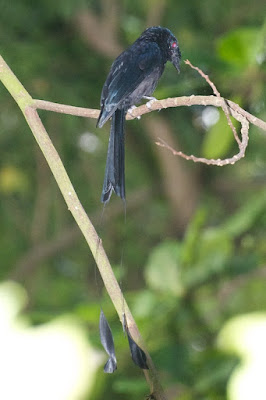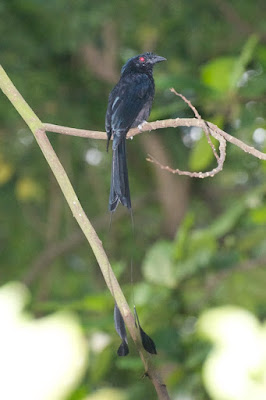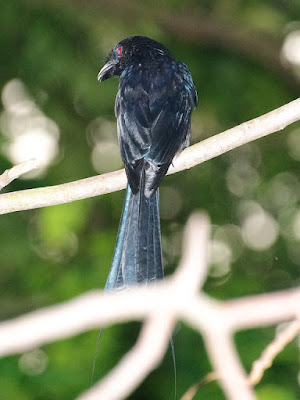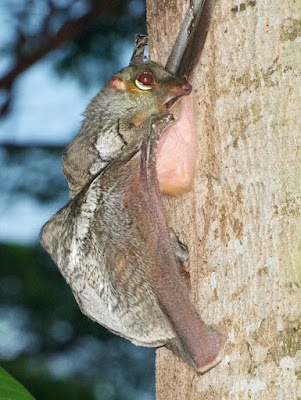Bukit Timah, Singapore's highest point, holds the only bit of real rain
forest left on the island. In 2014, the Singapore government closed the
Bukit Timah Reserve for unspecified "upgrades". Many local naturalists
were concerned that this might be a euphemism for urbanizing the area.
Our cousins Chris and Cynthia Chang took my grandson Ryan, his father Kevin and I to Bukit Timah for a late afternoon visit on September 13, 2014, just before the
reserve was to be closed for well over a year. We were concerned that it
might be the last chance to see the area (which I had first visited in
1972) as it was, but this has (fortunately) proven not to be the case.
We were greeted, at the park entrance, by a relatively rare sight: a blooming clump of Tiger Orchids (Grammatophyllum speciosum). Also known as the Queen of Orchids, this is the largest orchid in the world; an individual plant can weigh two tons. The species was once extirpated in Singapore, but the National Parks Board has now reintroduced it in a number of places.
Rather than walking up the summit trail into the forest, we decided to stay in the vicinity of the small lake near the entrance. There were certainly trees enough here (including this rather odd one - some sort of fig, perhaps, that has shed its fruit?).
Some raucous cries drew us to a male Greater Racket-tailed Drongo (Dicrurus paradiseus).
He seemed (as drongos often do) quite unconcerned by our presence; this close to the park entrance, I suppose, he must have had plenty of time to get used to people.
Neither did our presence seem to prevent this Plantain Squirrel (Callosciurus notatus) from going about its business.
The animal of the hour, though, was a very different sort of mammal indeed. Clinging to the side of a tree near the lake we found one of the most remarkable creatures in Singapore, a Sunda Colugo (Galeopterus variegatus). This is the creature usually known as a "flying lemur". It is neither a flyer nor a lemur, but it is a distant relative of primates (and hence of ourselves), and though it cannot fly it is probably the most accomplished glider in the natural world.
With the exception of its near cousin the Philippine Colugo (Cynocephalus volans), this is the only survivor of the once-widespread order Dermoptera. Colugos have the most extensive gliding surface of any mammal, going creatures like flying squirrels and sugar gliders one better by involving its tail in its gliding membrane. They can cover 100 metres in a single glide, but in compensation are utterly helpless on the ground and seemingly not much more mobile on a tree trunk.
This female, indeed, made no effort to get out of our sight as we watched and photographed her. She was blind in one eye, possibly because of an accident, but kept watch on us with her one good eye.
It is very important for a colugo to keep its gliding membrane, or patagium, in good condition. Grooming is vital, and the lower incisors of colugos have been modified to serve both as specialized grooming combs and as scrapers, used to scratch food from the surfaces of leaves.
Notice in the upper photograph that she is using her lower jaw, and presumably its specialized teeth, to comb her fur. It was because of her need to groom that I realized that this animal was a female; her patagium was doing double duty as a cradle, sheltering a tiny baby.
We spent a long time admiring and photographing (as Chris and Cynthia are doing) this remarkable and softly lovely animal. There may be only a thousand or so colugos left in Singapore, and now that Bukit Timah has opened again Singaporeans should have lots of chances to see them. Perhaps one will be the baby we saw in 2014 - who knows?
Friday, September 23, 2016
Monday, September 5, 2016
West Malaysia: Morning Runs at Bukit Gasing
Whenever Eileen and I go to Kuala Lumpur, as we did a few times while our grandson Royce was being treated in Singapore in 2014 (Eileen badly needed the break), we usually stay with our good friends Chips and Shirley. They are inveterate hikers, and when not off trekking in the Himalayas or some such place they spend their Saturday mornings trooping up the path at Bukit Gasing Forest Park, an abandoned rubber plantation that is a favourite resort of urban hiking enthusiasts. That's Chips and Shirley at the left of this picture, next to Eileen.
This writeup conflates two mornings at Bukit Gasing, on August 30 and September 7, 2014.
Chips and Shirley follow a well-used hiking loop, and Eileen goes with them, but I linger along the stream on the first part of the trail. It's a lot less work, and there is plenty to keep me occupied as I work my way back and forth.
There are, of course, attractive streamside plants for me to photograph, if not actually identify (though this appears to be the young leaf of a sort of fern).
The parallel main veins and ladder-like crossbars on the leaves of this plant suggest that this is some sort of melastome.
I have no idea what this plant, with its curiously-misshapen flowers, might be, but I would love to know. Can any of my readers enlighten me?
This one I can identify: a spikemoss (Selaginella), a non-flowering plant that forms a common ground cover on them loot of tropical forests around the world. Spikemosses are not mosses, but true vascular plants related to the equally-misnamed clubmosses (Lycopodiales).
Fungi provide photographic distractions of their own, whether they are bracket fungi...
... or mushrooms of various sorts.
These delicate little parasols may be a species of Omphalina or one of its relatives. Omphalinoids, as they are called, are agaric mushrooms, and are not edible.
I have made considerable efforts to try to find out what this streamside frog is, but without success. Once again, can one of my readers help me?
My chief objects of interest, as I worked my way back and forth along the edge of the stream, were two species of tiny damselfly - a fact that any of my long-term readers should fail to find surprising. Both are members of the Old-World tropical family Platycnemididae.
Coeliccia albicauda is a species I have featured here before (on my last writeup on a trip to Bukit Gasing, when the damselflies were memorably upstaged by a migrant Hooded Pitta) is the more delicate of the two. I usually found it clinging to a leaf tip; if you are at all familiar with spikemosses, the Selaginella frond in the lower photograph should give you an idea of how tiny this insect is.
Notice the conspicuously white genitalia; 'albicauda' means 'white-tailed'. The species ranges from Thailand to Singapore, where it is known as the White-tailed Sylvan.
Copera marginipes is known in Singapore as the Yellow Featherlegs, a reference to the feathery bristles on its legs that it uses as an insect trap. This is one of a number of damselflies, from different families, that use coloured legs as a display feature.
It, too, boasts white genitalia. As with many other damselflies, light or bright colours on the last abdominal segments can stand out like a heliograph even when the rest of the insect is almost invisible. Is this a display for other damselflies, a distraction for predators, or both?
A newly-emerged, or teneral, Copera marginipes raises no such issues. This so-called "ghost" phase (I do not know how long it lasts) makes this look like a totally different damselfly (also, this appears to be a female). I kept looking for damselflies that actually were different along the stream, but in the stretch I covered these two species seemed to have the place to themselves.
This writeup conflates two mornings at Bukit Gasing, on August 30 and September 7, 2014.
Chips and Shirley follow a well-used hiking loop, and Eileen goes with them, but I linger along the stream on the first part of the trail. It's a lot less work, and there is plenty to keep me occupied as I work my way back and forth.
There are, of course, attractive streamside plants for me to photograph, if not actually identify (though this appears to be the young leaf of a sort of fern).
The parallel main veins and ladder-like crossbars on the leaves of this plant suggest that this is some sort of melastome.
I have no idea what this plant, with its curiously-misshapen flowers, might be, but I would love to know. Can any of my readers enlighten me?
This one I can identify: a spikemoss (Selaginella), a non-flowering plant that forms a common ground cover on them loot of tropical forests around the world. Spikemosses are not mosses, but true vascular plants related to the equally-misnamed clubmosses (Lycopodiales).
Fungi provide photographic distractions of their own, whether they are bracket fungi...
... or mushrooms of various sorts.
These delicate little parasols may be a species of Omphalina or one of its relatives. Omphalinoids, as they are called, are agaric mushrooms, and are not edible.
I have made considerable efforts to try to find out what this streamside frog is, but without success. Once again, can one of my readers help me?
My chief objects of interest, as I worked my way back and forth along the edge of the stream, were two species of tiny damselfly - a fact that any of my long-term readers should fail to find surprising. Both are members of the Old-World tropical family Platycnemididae.
Coeliccia albicauda is a species I have featured here before (on my last writeup on a trip to Bukit Gasing, when the damselflies were memorably upstaged by a migrant Hooded Pitta) is the more delicate of the two. I usually found it clinging to a leaf tip; if you are at all familiar with spikemosses, the Selaginella frond in the lower photograph should give you an idea of how tiny this insect is.
Notice the conspicuously white genitalia; 'albicauda' means 'white-tailed'. The species ranges from Thailand to Singapore, where it is known as the White-tailed Sylvan.
Copera marginipes is known in Singapore as the Yellow Featherlegs, a reference to the feathery bristles on its legs that it uses as an insect trap. This is one of a number of damselflies, from different families, that use coloured legs as a display feature.
It, too, boasts white genitalia. As with many other damselflies, light or bright colours on the last abdominal segments can stand out like a heliograph even when the rest of the insect is almost invisible. Is this a display for other damselflies, a distraction for predators, or both?
A newly-emerged, or teneral, Copera marginipes raises no such issues. This so-called "ghost" phase (I do not know how long it lasts) makes this look like a totally different damselfly (also, this appears to be a female). I kept looking for damselflies that actually were different along the stream, but in the stretch I covered these two species seemed to have the place to themselves.
Subscribe to:
Posts (Atom)



















































